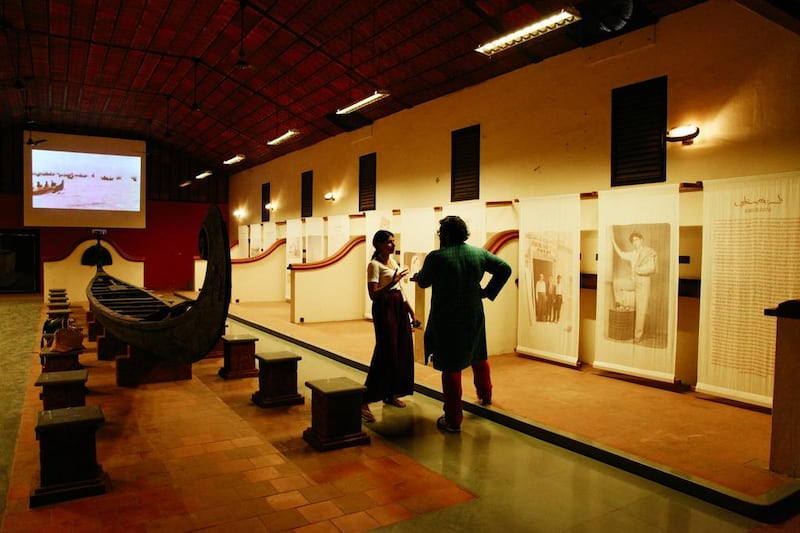In the historic Fort Kochi, on the southern Indian coast, which is dominated by Portuguese architecture and fishing, a major art festival is in full swing.
In one of the colonial buildings dedicated to the three-and-a-half-month-long festival, visitors stumble across a dhow that dominates the room. The sound of waves echoes around the wooden interiors, as do the haunting songs of sailors, and the real-life stories of Indians and Emiratis who made their way between the shores of India and the UAE, and before that the Trucial States, decades ago.
The audiovisual installation Hoisting Histories is by Kuwaiti artist Rasha Al Duwaisan, who has lived in Dubai for the past few years. It is part of the exhibition Binary States, India – UAE, which explores the ties between the two countries and the overlapping aspects of their cultures.
The exhibition was commissioned by the Ministry of Foreign Affairs and International Cooperation, UAE, and produced by Cultural Engineering.
In Hoisting Histories, historical excerpts are shared in audio form, and stories and photos are printed on tapestries dotted around the room, made of material similar to what was used for the sails of the dhows that carried migrants.
Al Duwaisan, who found and interviewed subjects for her project, says capturing these elements through art is an important way of recording and sharing a history of the migration between the countries, and the stories that might go untold and be lost forever.
“That story of the movement of people between the Gulf and India is something that fascinates me,” she says.
“That sense of arrival to such a different place, that expectation, what that felt like on an emotional and psychological level.”
She adds that the biggest challenge was “turning oral history into art … and the intangible into the tangible”.
We learn, for example, of Shihab Ghanem, an Emirati poet and engineer who completed his master’s degree in the north Indian state of Uttarakhand in 1975 and travelled throughout the country.
He tells us how his connections to India go way back because his grandfather was friends with Mahatma Gandhi. Ghanem himself has, over the years, translated the work of countless Indian poets into Arabic.
Some of the stories are tinged with sadness. Nostalgia runs deep, as the Indian subjects relate the past simplicity of the UAE, which was dominated by desert and little else when they first arrived – a landscape and social environment that has changed dramatically, beyond recognition and beyond return.
Zulekha Daud, a doctor from Nagpur, India, tells us that she had not even heard of Dubai before she moved there in 1964.
“No roads were here,” reads Dr Daud’s narrative. “All this was sand. We used to go on picnics in the night.”
Binary States is part of the Kochi-Muziris Biennale, an international contemporary art festival that features an eclectic array of work and is in its third edition.
Alongside Al Duwaisan’s work, there are projects by two other artists in the exhibition, which represents more of a historical or anthropological approach rather than showcasing highly creative artistic endeavours.
Ammar Al Attar, a photographer and mixed-media artist from Ajman, put together a photo-documentation display titled Reverse Moments.
It tells the story of Prem Ratnam, a photographer from Kerala who moved to Sharjah in 1971 and still lives and works here. Photographs, documents and cameras are used to tell the story of Ratnam’s journey during his career in the UAE, starting with a copy of his original passport and stamp that marked his arrival in the country along with some of his photos.
“There is of course a big relation between the UAE and India,” says Al Attar.
“There are a lot of Indian communities in the UAE and they have been here since even before the formation of the UAE and they have contributed a lot to the UAE. As a photographer, the first owner of a studio in Dubai was an Indian in the 1950s.”
He explains he wanted to reveal the history of Ratnam, who “did a lot of work that is not valued … which is important to show to people because it is part of a very important history of the country”.
It is no coincidence the exhibition is in Kerala, as Keralites form the largest group of Indians in the expatriate community in the UAE.
The third artist is Vikram Divecha, who is based in Dubai and describes himself as "Beirut-born" and "Mumbai-bred". He made a film called Veedu, which is being shown as part of the exhibition. The title is the word for "house" in Malayalam, the language of Kerala.
Divecha’s film documents the true stories of two UAE-based Keralites who are commissioning an architectural firm in Kerala to build houses for them in their native state. The film reveals how one of the expats has gone so far as to base the design of his house on a villa in Dubai near his office, sending photographs of the property to the architects so they can copy the structure.
Umer Butt, the founder and co-director of Grey Noise, an art gallery in Dubai, and co-curator of Binary States, says that the whole presentation "manifests a strong bilateral dialogue between two historic ports countries … a love affair that still continues".
• The Kochi-Muziris Biennale runs in Fort Kochi, Kerala, India, until March 29
artslife@thenational.ae





